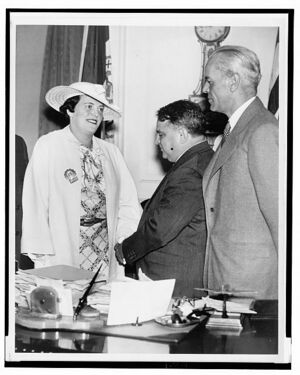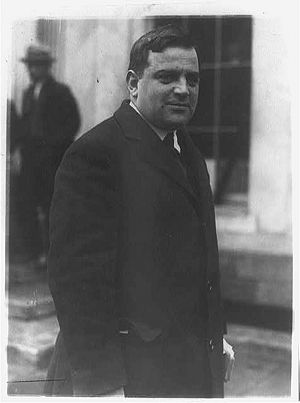Fiorello LaGuardia
Fiorello Henry LaGuardia (born Fiorello Enrico LaGuardia, often spelled La Guardia, pronunciation [la 'gwardja], 1882-1947) was an American politician who served as Mayor of New York City for three terms from 1934 to 1945. Previously he represented New York in the House of Representatives from 1917 to 1919, and from 1922 to 1933. Irrascible and charismatic, he liked people to call him "the Little Flower," from the translation of Fiorello as flower, along with a reference to his short stature.
LaGuardia, a nominal Republican who appealed across party lines, was very popular in New York during the 1930s. As a New Dealer, he supported President Franklin D. Roosevelt. and in turn Roosevelt heavily funded the city and cut off patronage from LaGuardia's foes. In 1941, while remaining mayor, he became the national Director of Civilian Defense, but did a mediocre job. Unable to move into national circles, he left office at the start of 1946 and became briefly the director-general of United Nations Relief and Rehabilitation Administration.
LaGuardia was a domineering leader whose reform politics were carefully tailored to reflect and exploit the sensibilities of his kaleidoscopic constituency. He defeated a corrupt Democratic machine, presided during a depression and a world war, made the city the model for New Deal welfare and public works programs and championed immigrants and ethnics. He succeeded with the support of a sympathetic president. He secured his place in history as a tough minded reform mayor who helped clean out corruption, bring in gifted experts, and fix upon the city a broad sense of responsibility for its own citizens. His administration engaged new groups that had been kept out of the political system, gave New York its modern infrastructure and raised expectations of new levels of urban possibility. He left no doubt who was in charge, but he lost his touch during the wars years and never realized that he had created far more infrastructure than the city could afford. La Guardia represented a dangerous style of personal rule hitched to a transcendent purpose, according to Thomas Kessner, La Guardia's biographer. People would be afraid of allowing anybody to take that kind of power today.[1]
Early life and career
LaGuardia was born in New York City to poor immigrants who came to America in 1880: Achille La Guardia, an Italian father who no longer practiced Catholicism, and Irene Cohen Luzzato, an Italian mother of Jewish origin. He was raised an Episcopalian and spent most of his childhood in Prescott, Arizona. The family moved to his mother's hometown after his father was discharged from his bandmaster position in the U.S. Army in 1898. LaGuardia served in U.S. consulates in Budapest, Trieste, and Fiume (1901–1906). Fiorello returned to the U.S. to continue his education at New York University, and during this time he worked for New York Society for the Prevention of Cruelty for Children and as a translator for the U.S. Immigration Service at Ellis Island (1907–1910).
Political career
LaGuardia began serving as the Deputy Attorney General of New York in 1914. He lost his first race for Congress in 1914, but was elected in 1916 from East Harlem, at the time heavily Italian. In the U.S. House of Representatives he developed a reputation as a fierce and devoted reformer. In Congress, LaGuardia represented
Military service
LaGuardia briefly served in the armed forces from 1917 to 1919, commanding a unit of the United States Army Air Service on the Italian/Austrian front in World War I, rising to the rank of major.
In 1921 his new baby and then his wife died of tuberculosis. LaGuardia, still in Congress, became depressed, and turned to a long alcoholic binge. He recovered and became a teetotaler.
Congressman again
LaGuardia ran for the House of Representative again in 1922. He won the election and served as a congressman until 1933. He insisted that government must not lock out immigrants and that it must accord them equal opportunities to a decent life, and advocate for many reform measures, especially on behahlf of labor unions. One major legislation bearing his name was Norris-LaGuardia Act, which he sponsored with Nebraska senator George Norris in 1932. The Act banned yellow-dog contracts, which are labor contracts prohibiting a worker from joining a union.
In 1929, he launched a bid for New York's mayorship, but lost by a landslide to incumbent Democrat Jimmy Walker. In 1932, he lost his House seat to James J. Lanzetta, a Democrat.
Mayor of New York

LaGuardia was elected mayor of New York City on an anti-corruption Fusion ticket, which united him in an uneasy alliance with New York's Jewish population and upper class liberals.
Being of Italian descent and growing up during the period when crime was rampant in the Bronx, LaGuardia had a loathing for the gangsters who gave the Italian community a negative reputation. He took a strong stance against organized crime. When he was first elected in 1933, he ordered the police chief to arrest Lucky Luciano, an infamous mobster, regardless of the charge he could be indicted. He addressed in the radio through his high-pitched, squeaky voice, "Let's drive the bums out of town." In 1934, he conducted a search-and-destroy raid on slot machines operated by gangster Frank Costello, making thousands of arrests, swinging the sledgehammer and dumping the slot machines into water to show the media his toughness. In 1936, he instructed Thomas E. Dewey, a special prosecutor and future Republican candidate for president, to prosecute Luciano. Dewey investigated into Luciano's prostitution ring, and Luciano was sentenced to 30-50 years in prison.
LaGuardia rarely followed Republican party lines. In elections he also ran as the nominee of the American Labor Party, a union-dominated anti-Tammany grouping that also ran FDR for President from 1936 onward. LaGuardia supported Roosevelt, who was a Democrat, for president. He chaired the Independent Committee for Roosevelt and Wallace with Norris in the 1940 presidential election.
His massive public works programs administered by his friend and ally Parks Commissioner Robert Moses employed thousands of men and created ghighways, bridges, parks, swimming pools, and, indeed, much of the modern infrastructure of the city. When the newspapers went on strike he read the funny papers on the radio. He built a major airport in Queens, LaGuardia Airport. Responding to popular disdain for the sometimes corrupt City Council, LaGuardia successfully proposed a reformed 1938 City Charter which created a powerful new New York City Board of Estimate, similar to a corporate board of directors.
He fiercely denounced Adolf Hitler and the Nazi regime. As early as 1934, LaGuardia warned, "Part of Hitler’s program is the complete annihilation of the Jews in Germany."
In 1941, during the run-up to American involvement in World War II, President Roosevelt appointed LaGuardia as the first director of the new Office of Civilian Defense (OCD). The OCD was responsible for preparing for blackouts, air raid wardens, sirens, and shelters in case of German air raids. The government knew that such air raids were impossible but the goal was to psychologically mobilize many thousands of middle class volunteers to make them feel part of the war effort. LaGuardia remained Mayor of New York, but after Pearl Harbor in December 1941 his role was turned over to full-time director of OCD, James M. Landis.
LaGuardia enjoyed officiating in municipal court. He handled routine misdemeanor cases, including, as Cerf wrote, a man who had stolen a loaf of bread for his starving family. LaGuardia still insisted on levying the fine of ten dollars. Then he said "I'm fining everyone in this courtroom fifty cents for living in a city where a man has to steal bread in order to eat!" He passed his hat and gave the fines to the defendant, who left the court with $47.50.[2]
Later life
LaGuardia was the director general for the United Nations Relief and Rehabilitation Administration (UNRRA) in 1946.
LaGuardia loved music and conducting, and was famous for spontaneously conducting professional and student orchestras that he visited. He once said that the "most hopeful accomplishment" of his long administration as mayor was the creation of the High School of Music & Art in 1936, now the Fiorello H. LaGuardia High School of Music & Art and Performing Arts[3]. He died at his 5020 Goodridge Avenue home, in the Riverdale section of the Bronx, of pancreatic cancer at the age of 64 and is interred at Woodlawn Cemetery in the Bronx.
A man of very short stature, LaGuardia's height is sometimes given as five feet. According to an article in the official weblog of New York Times, however, his actual height was five feet, two inches. [4]
Recognition and Legacy
Historians have recognized LaGuardia as the greatest mayor in American history, and perhaps the greatest in New York City, but some experts match him with Rudy Giuliani).[5]
In addition to LaGuardia Community College and LaGuardia High School, a number of other institutions in New York and streets around the world are named for him, LaGuardia Airport, the smaller and older of New York's two currently operating international airports, honors his name.
He was the subject of the Pulitzer Prize-winning Broadway musical Fiorello!.
Further reading
- Bayor, Ronald H. Fiorello La Guardia: Ethnicity and Reform. (1993). 213 pp.
- Brodsky, Alyn. The Great Mayor: Fiorello La Guardia and the Making of the City of New York. (2003). 530 pp.
- Jeffers, H. Paul. The Napoleon of New York: Mayor Fiorello La Guardia 392 pp. online edition
- Kessner, Thomas. "Fiorello H. Laguardia." History Teacher 1993 26(2): 151-159. Issn: 0018-2745 in Jstor]
- Zinn, Howard. Laguardia in Congress (1959) [ online edition]
notes
- ↑ Sam Roberts, "The Giuliani Years: History; La Guardia's Legacy Is Formidable, but it May Be Surpassed," New York Times New York Times April 18, 2008
- ↑ Fiorello La Guardia legend
- ↑ Steigman, Benjamin: Accent on Talent -- New York's High School of Music & Art Wayne State University Press, 1984 ISBN 0686879759
- ↑ Sewell Chan, The Mayor’s Tall Tales, New York Times Blog, December 4, 2006.
- ↑ He was first in Melvin G. Holli, The American Mayor (1993); Sam Roberts, "The Giuliani Years: History; La Guardia's Legacy Is Formidable, but it May Be Surpassed," New York Times New York Times April 18, 2008
